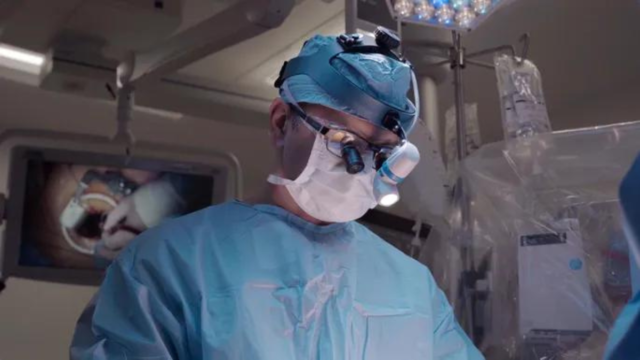Neelan Doolabh, M.D.Director of Minimally Invasive Heart Valve Surgery Cardiovascular and Thoracic Surgery

The man sitting across from me had traveled a long way from Saudi Arabia. He needed heart valve surgery. He could have had traditional surgery at home, but he wanted to know if we could fix his valve without the pain of breaking his breastbone. I told him we could – with minimally invasive heart valve surgery.
Unfortunately, far too many people don’t know about minimally invasive heart valve surgery. This is partly because these procedures are fairly new, so only a few doctors perform them. In fact, fewer than 1 percent of aortic valve surgeries worldwide are performed this way, as well as fewer than 20 percent of mitral valve surgeries.
Minimally invasive heart valve surgeries take less time to complete, and patients generally have fewer complications and recover faster – in as few as 10 days compared with six to eight weeks after traditional surgery. That means you can get back to work and your normal activities that much sooner. Patients also benefit from smaller, less noticeable scarring from minimally invasive heart valve surgery compared to traditional open surgery.
No Broken Bones
Aortic valve replacement, mitral valve repair or replacement, tricuspid or pulmonary valve repairs or replacements are just a few of the procedures Dr. Doolabh routinely performs through a minimally invasive approach. Click below to learn more and talk directly with Dr. Doolabh’s team.
Not all “minimally invasive” heart valve surgeries are created equal. Some centers say they do these procedures, and while they make a smaller incision than traditional surgery, they still crack open part of the breastbone. This is called a partial sternotomy and it is not the approach I use. When I say minimally invasive, I mean we don’t break any bones.
Minimally invasive valve surgery joins the ranks of other advanced heart procedures such as transaortic valve replacement (TAVR) and MitraClip mitral valve repair, which often result in quicker recoveries than traditional open surgeries. However, my approach is a full surgery, not an interventional procedure. Let’s discuss how minimally invasive heart valve surgery works, who is eligible, and what to ask your doctor if you need heart valve surgery.
How does minimally invasive heart valve surgery work?
There are four valves in the heart: the aortic valve, mitral valve, pulmonary valve, and the tricuspid valve. These valves open and close to allow blood to pass through the different chambers of the heart and distribute oxygen-rich blood throughout the body. Malfunction of any of these valves can cause inefficient blood flow.
Three main problems can arise when a valve doesn’t work properly:
- The valve doesn’t close completely, allowing blood to leak back into the heart. This is known as regurgitation.
- The valve doesn’t open fully, which reduces blood flow out of the heart. This is known as stenosis.
- An infection damages or destroys the valve, known as endocarditis.

Traditionally, surgeons would access the valve by making a 12-inch incision down the middle of your chest and breaking the sternum, or breastbone, in half. You may have heard this called “cracking the chest.” This surgery can take four to six hours to perform, and you’ll need six to eight weeks to recover. Your range of motion will be limited to keep the sternum stable as it heals.
But with minimally invasive heart valve surgery, we can avoid cracking the chest and thus significantly shorten the recovery period. We make an incision of 2 inches or less and reach the heart through the ribs. We don’t break any bones. The procedure takes about two hours, and most patients are moving around and driving in as few as 10 days.
Some doctors use a surgical robot for this procedure, but that requires multiple small incisions and takes longer. When it comes to minimally invasive heart valve surgery, the robot can’t do it nearly as well or quickly as a human doctor.
Who is a candidate for minimally invasive heart valve surgery?
Although there are rare cases in which I would recommend traditional surgery, most people are eligible for a minimally invasive surgery.
It’s common for people to hear that they’re too old, sick, or frail to have heart valve surgery. They may not be physically able to handle a long procedure or recovery period. If they have bad knees or hips and rely on their arms to stabilize themselves, it can be even more difficult to allow the breastbone to heal following traditional heart valve surgery.
This is not a problem with the minimally invasive procedure. The surgery is much shorter, which eliminates some potential complications from being under general anesthesia for a long time. And because we don’t crack the breastbone, there’s no time needed for it to heal.
Minimally invasive surgery also is preferable for patients who need to return to work to pay the bills. Instead of waiting a month or more, they’ll likely be back to work much quicker.
The Heart Valve Hotline
Steva Smartt, R.N. is the valve intake coordinator for Dr. Neelan Doolabh, and she handles the entire referral process, including answering a cell phone that patients can call 24/7.
What to ask about your doctor’s experience
This procedure is still pretty new. It’s not everyday stuff for every facility. Not every doctor can perform it.
I feel bad when I talk with people who’ve had traditional heart valve surgery simply because they didn’t know a minimally invasive option existed. Commonly, these people were treated in reputable medical centers. They simply didn’t know to ask. I hope that changes soon and everyone who wants minimally invasive heart valve surgery can get it.
Whether you need a heart valve replaced or are seeking another minimally invasive heart procedure such as TAVR, ask your doctor:
– How many minimally invasive surgeries have you performed?
– What are your results, including:
- Kidney failure rate
- Length of hospital stay
- Stroke rate
- Transfusion rate
If you’re told you need heart valve surgery, ask about minimally invasive options. If your doctor doesn’t offer them, ask for a referral or seek a second opinion. You may have to travel, but it will be worth it.
Learn more about Dr. Doolabh’s minimally invasive heart valve surgical procedure.

Come for a second opinion
If you’ve been told you need heart valve surgery, ask your doctor about minimally invasive surgical options. If he doesn’t offer any, come to UT Southwestern for a second opinion. You may have to travel, but it will be worth it.









You must be logged in to post a comment Login